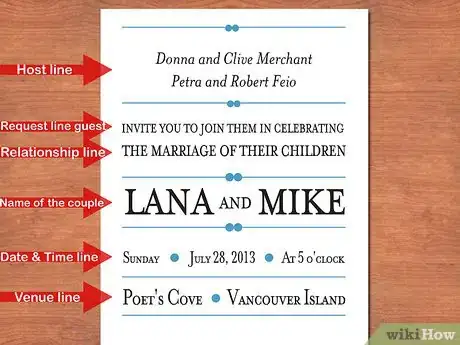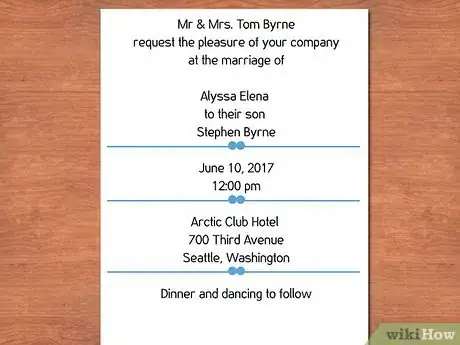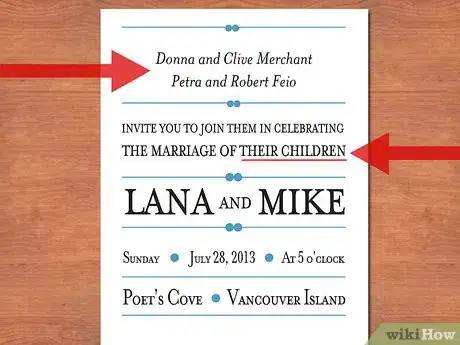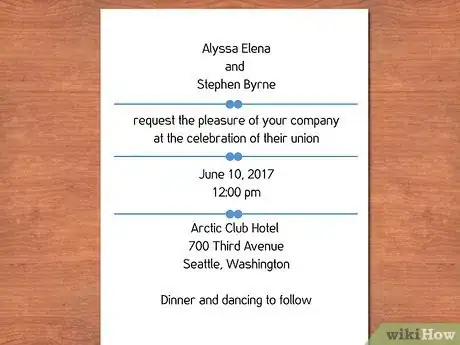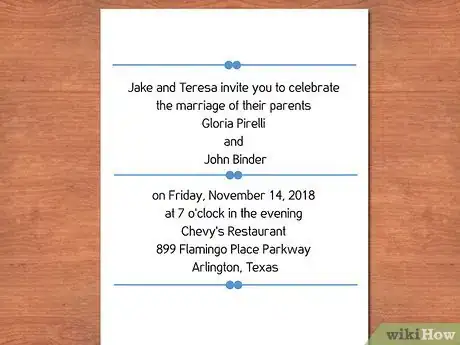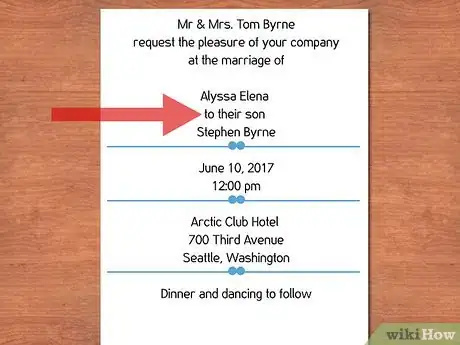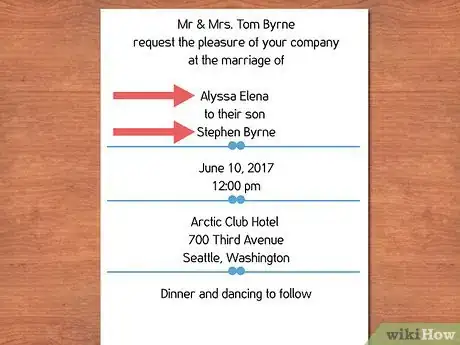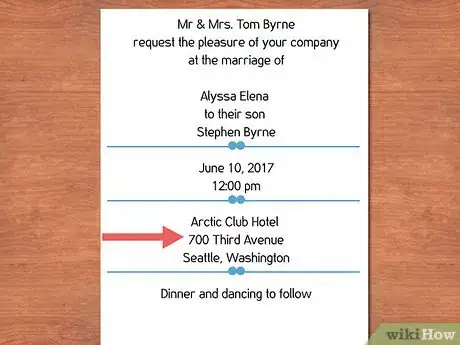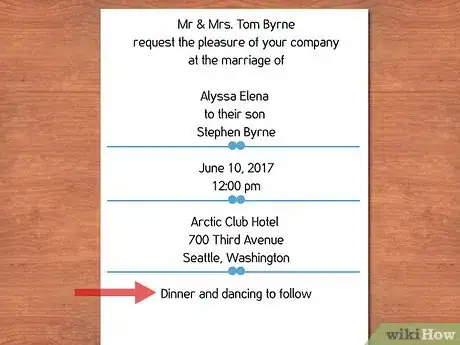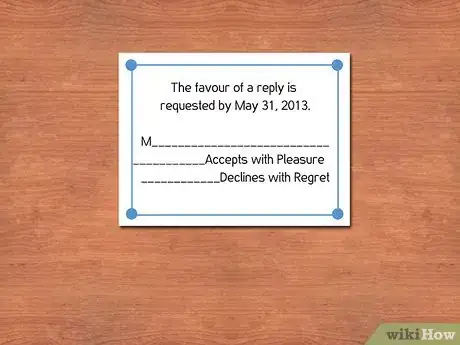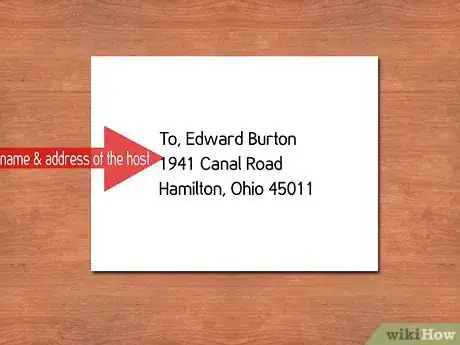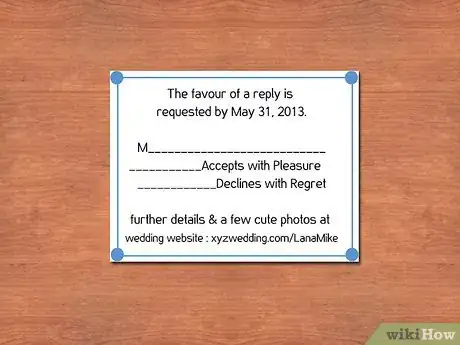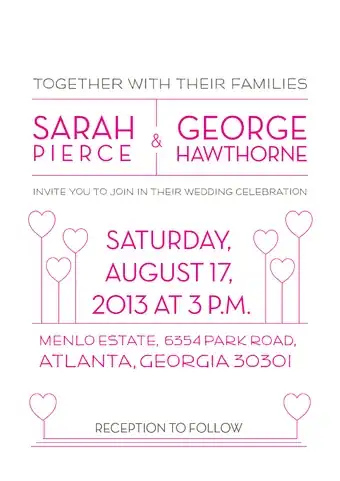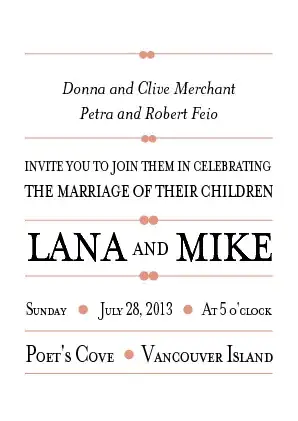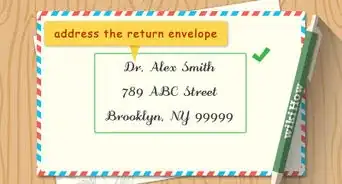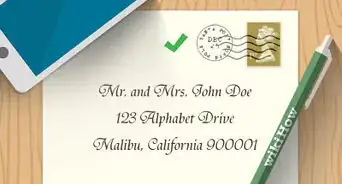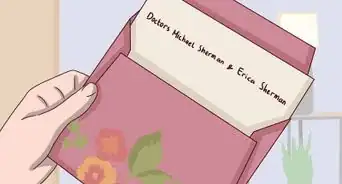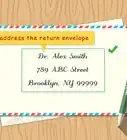This article was co-authored by Hovik Harutyunyan. Hovik Harutyunyan is an Event and Wedding Planner and the Owner of Hovik Harutyunyan Events, a full-service event planning firm based in Los Angeles, California. Hovik has over ten years of hospitality and event planning experience. His firm specializes in weddings, private celebrations, and corporate events. Hovik's work has been featured in Vogue, Martha Stewart Weddings, and Modern Luxury Weddings. He has a BA in Economics from the University of California, Berkeley.
There are 9 references cited in this article, which can be found at the bottom of the page.
This article has been viewed 227,109 times.
Weddings require a great deal of work and preparation, and the invitations are an important detail that shouldn't be overlooked. For one, the invitation may be the first project that you and your betrothed work on together that the world will see. Second, without the invitation, guests wouldn’t know when and where to show up for your wedding! Because of this, writing a wedding invitation can be challenging, since you need to provide all the right information without being overly wordy, and you need to pick a writing style and creativity level that suits you, your families, and your guests.
Steps
Introducing the Hosts
-
1Understand the parts of an invitation. A formal wedding invitation is often divided into several lines, all of which provide pertinent information about the ceremony, reception, and those involved. The lines of a wedding invitation include the:[1]
- Host line, where the names of the people hosting the wedding open the invitation
- Request line, where the invitation is formally put forward to the guest
- Relationship line, where it’s indicated how the hosts are related to the couple
- Name of the couple
- Date line
- Time line
- Venue line
- Address line, which states the address and location of the ceremony venue
- Reception line, which explains what type of reception or party will take place afterward and where
-
2Determine the host. Traditionally, the host of a wedding was the person paying for it, but today, this is an honor that the couple can bestow upon any chosen loved one.[2] When you look at a wedding invitation that says something like “Emily and John Gordon request your presence at the marriage of their children,” Emily and John Gordon are the hosts who are extending the invitation. The wedding host is most often:
- A bride’s parents
- A groom’s parents
- The couple and their parents
- The couple alone
Advertisement -
3Use the bride’s or groom’s parents as the host. When a bride or groom’s parents host a wedding, their names are the first to appear on the invitation.
- Typically, you will use courtesy titles followed by the surname (Mr. and Mrs. Gordon), or courtesy titles followed by the husband’s full name (Mr. and Mrs. John Gordon).
-
4Use both parents as the host. If it’s a bride and groom getting married, the first line will typically have the name of the bride’s parents (Mr. and Mrs. John Gordon). The second line will begin with “and” followed by the name of the groom’s parents (and Mr. and Mrs. James Burrows).
- If two brides or two grooms are getting married, the formatting will be the same, but you will have to choose whose parents come first. However, you can also put all the parents on the same line.
-
5Use the couple and their parents as the host. When the couple and both sets of parents are hosting the wedding, it is customary to open the invitation by saying something that indicates everyone is involved, such as:[3]
- Together with their parents
- Together with Mr. and Mrs. John Gordon and Mr. and Mrs. James Smith
-
6Use the names of the couple as the host. When the couple themselves choose to host their own wedding, their full names appear at the very beginning of the invitation.
-
7Use the names of children to invite guests to a second marriage. In the instance of a second marriage, it’s not uncommon to open a wedding invitation with the first names of the children—instead of the hosts—from the new couple’s previous marriages. [6]
Extending the Invitation
-
1Write the request line. Once the name of the host has been stated, it’s time to actually extend the invitation to the guests. This is often done with wording along the lines of:
- “Request the honor of your presence,” which is usually reserved for religious services.
- “Request the pleasure/honor of your company,” which is usually used when a service will not be religious.[7]
- “Invite you to celebrate with them”
- “Would like you to help celebrate”
-
2Indicate the relationship between the host and the couple. In the next line, you can explain how the host is related to the couple. There are several different wording choices you can use depending on the relationship.
- When the hosts are a bride’s parents, you can say “at the marriage of their daughter”
- When both parents are hosting, you can say “at the marriage of their children”
- When a groom’s parents are the hosts, the next line can simply be “at the marriage of”
- When the couple is hosting, you can say “at the celebration of their wedding/union”
- When an invitation has been extended by children from previous marriages, the relationship line can say something like “at the ceremony that will unite them as brother and sister”[8]
-
3Introduce the couple. When there is a bride and groom, the bride’s name traditionally comes first; if there is more than one bride or no bride, you will have to decide whose name appears first.
- Feel free to include a bride and groom’s full names; traditionally, however, only the bride’s first and middle names appeared on invitations, because the bride’s parents paid for the wedding, so her surname was already mentioned.
- When the groom’s parents are the hosts, it is sometimes necessary to write “to their son” between the bride’s name and the groom’s, so the invitation is stated as “Mr. and Mrs. James Burrows request the honor of your presence at the marriage of Catherine Renee to their son Ryan Kevin Burrows.”
Providing Necessary Information
-
1Include the date. Once the host has invited the guest and introduced the couple, it’s time to include all the relevant details about time and place. First comes the date of the wedding, followed by the time on the next line.[9]
- On a traditional, formal wedding invitation, the names of all times and dates are spelled out (write “Monday the second of March” as opposed to “Monday, March 2”)[10]
- Similarly, instead of writing 2:00 p.m. on a formal invitation, you would instead write out two o’clock in the afternoon.
-
2
-
3Write the reception line. This tells guests what to expect after the ceremony. If the wedding ceremony will be followed by dinner and dancing at the same venue or a different location, now’s the time to let your guests know. This can often be something simple, such as:
- “Dinner and dancing to follow”
- “Reception to follow”
- “Party to follow,” and be sure to note a time and new location if applicable
-
4Make note of any special requests. For example, if children aren’t permitted, you can write “adult reception” on the reception card. Similarly, you can also indicate a dress code in the reception line, such as “black-tie reception to follow.”[13]
- To tell guests delicately that children are not invited, you can also have a box on the RSVP card that asks you to indicate how many adults will be attending.[14]
Getting Guests to RSVP
-
1Include an RSVP card. Unless you want guests to reply by telephone or through a wedding website, it’s best to include a physical card that guests can mail back in response to the invitation.
-
2Pre-print the response envelopes with the hosts name and address. To encourage people to respond by mail, make it as easy as possible by providing pre-printed envelopes so they don’t even have to address the RSVP themselves.
- Write the full names on the center of the envelope. Address married couples with the same last name together.
- The return address should be the name and address of the hosts, and not necessarily the bride and groom.[15]
-
3
Sample Wedding Invitations
Sample RSVP Cards
Community Q&A
-
QuestionHow do I state that attendance is by invitation only?
 SherringfordCommunity AnswerI would have that at the bottom of the card exactly as you have it: "Attendance by invitation only."
SherringfordCommunity AnswerI would have that at the bottom of the card exactly as you have it: "Attendance by invitation only." -
QuestionWhen should I capitalize words?
 Ananyaa NairCommunity AnswerCapitalize all proper nouns and the first letter of the first word in a sentence. Proper nouns include names of people, places, animals, and things.
Ananyaa NairCommunity AnswerCapitalize all proper nouns and the first letter of the first word in a sentence. Proper nouns include names of people, places, animals, and things. -
QuestionIs there another phrase to use besides, "together with their parents?"
 Community AnswerYes. You could say anything you want in your invite, depending on the parties' individual situations and wishes.
Community AnswerYes. You could say anything you want in your invite, depending on the parties' individual situations and wishes.
References
- ↑ https://www.theknot.com/content/standard-wedding-invitation-wording-examples
- ↑ http://apracticalwedding.com/2015/01/wedding-invitation-wording-samples/
- ↑ https://www.weddingpaperdivas.com/wedding-invitation-wording.htm
- ↑ http://www.confetti.co.uk/organising-planning/stationery/choosing-the-right-wording-for-your-wedding-invitations
- ↑ http://www.beau-coup.com/wedding-invitations-etiquette-proper-wording.htm
- ↑ https://www.weddingpaperdivas.com/wedding-tips-and-ideas/wedding-invitation-wording.htm
- ↑ http://www.beau-coup.com/wedding-invitations-etiquette-proper-wording.htm
- ↑ http://www.invitationconsultants.com/samplewording.aspx?p_subcategory=199
- ↑ https://www.theknot.com/content/standard-wedding-invitation-wording-examples
- ↑ https://www.weddingpaperdivas.com/wedding-invitation-wording.htm
- ↑ http://www.confetti.co.uk/organising-planning/stationery/choosing-the-right-wording-for-your-wedding-invitations
- ↑ http://apracticalwedding.com/2015/01/wedding-invitation-wording-samples/
- ↑ Hovik Harutyunyan. Event & Wedding Planner. Expert Interview. 21 Febrary 2020.
- ↑ http://www.beau-coup.com/wedding-invitations-etiquette-proper-wording.htm
- ↑ http://www.beau-coup.com/wedding-invitations-etiquette-proper-wording.htm
- ↑ Hovik Harutyunyan. Event & Wedding Planner. Expert Interview. 21 Febrary 2020.
- ↑ http://offbeatbride.com/2007/12/wedding-invitation-wording-that-wont-make-you-barf
About This Article
To write a wedding invitation, start by writing the full names of the hosts, such as the bride’s parents or the couple, at the top of the invitation. On the next line, write “Request the honor of your presence,” for a religious ceremony or “Invite you to celebrate with them” for a less formal event. Next, provide the necessary information, such as the date, time, and location of the wedding. Finally, close the invitation with information about the reception or any dress code requests. To learn more, like how to make it easy for your guests to RSVP, read on!
